On the southern back road out of Ifrane, heading toward Azrou, there’s a kind of squatter’s community on the open ground to the right of the road. This town is known as Tarmilat; it’s home to a group of shepherds. The original families came to this area some 50-60 years ago, right around independence. Probably they looked after sheep for the French, or perhaps for wealthy Moroccans collaborating with the French.
Now there are some 50 families living here, in houses built from stone, roofed with large tin cans that have been cut open and flattened.
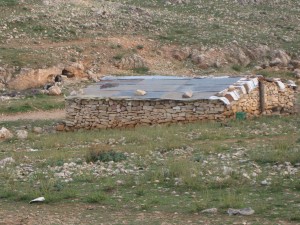
The contrast with the royal palace, whose entrance is across the road, a little ways back, is striking.
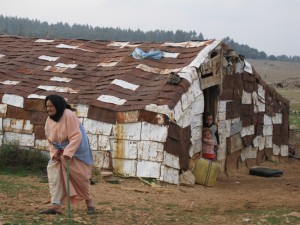
Karen Smith, Christian pastor at Al Akhawayn University (AUI), has brought a group of AUI affiliated folks–mostly students, a few faculty–out to Tarmilat to purchase rugs and bags and share a meal with the women weavers.
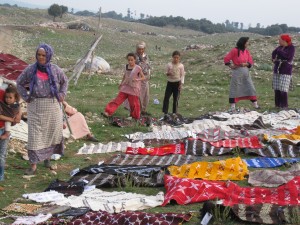
Half a dozen years ago, a group of high school students, working with an AUI-affiliated organization called Hand in Hand wanted to raise money to help the people of Tarmilat. Karen, a member of Hand in Hand, insisted that they begin by meeting the women and finding out what the women themselves needed and wanted. What they wanted most was to form themselves into a weaving cooperative, even though only a few had weaving skills.
Karen remembers driving one of the women and her baby up to Tangier to learn from a successful cooperative there about how to form such an organization. Imazighen women don’t diaper their babies–something Karen hadn’t yet learned–so she had no sheets or towels to protect or clean the car or the mother. “It was an experience!”
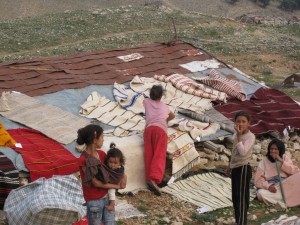
The Tarmilat weaving cooperative has been very successful, leading to other changes in the community. To begin with, none of the women could read or keep track of numbers, so there was one man serving as treasurer for the collective. “One man and twenty eight women: that was never going to last!” says Karen. (Someone else told me later that the treasurer was accused of stealing the women’s money.) Perhaps as a result of this experience, the women were very concerned that their children go to school. But the nearest school was in Ifrane itself, some five kilometres away down a road not safe for pedestrians.
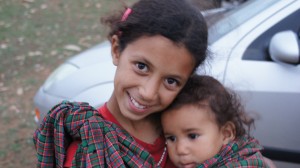
The community started trying to build more permanent structures, claiming Karen had told them this was necessary for their cooperative (not true). These structures were impermissible and had to be taken down. But when it came to a school, the women pulled every string they had access to: the biggest string was Hand in Hand, with the governor’s wife on board. Wala! (Voilà!) The community now has a cement school and even a mosque–but the homes remain stone-and-recycled-can structures.
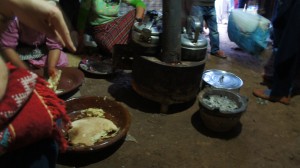
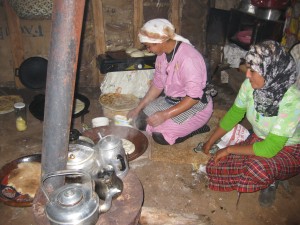 Inside most of the buildings, it’s dark and a little smokey–but the home-made bread, butter, and tea is delicious. In the right-hand photo above, the blue-and-white thing in the upper right corner is a “churn” for making butter: it’s a kind of swing in which the cream is pushed back and forth to make it slosh around until it solidifies. This cooking hut is warm with the fire, so many of us crowd in briefly to get out of the chilly wind. To our right is one of the community’s looms, with a rug in process:
Inside most of the buildings, it’s dark and a little smokey–but the home-made bread, butter, and tea is delicious. In the right-hand photo above, the blue-and-white thing in the upper right corner is a “churn” for making butter: it’s a kind of swing in which the cream is pushed back and forth to make it slosh around until it solidifies. This cooking hut is warm with the fire, so many of us crowd in briefly to get out of the chilly wind. To our right is one of the community’s looms, with a rug in process:
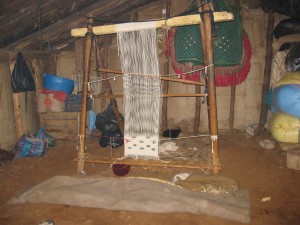
Our family buys two “lap rugs” (thick and small) against the coming winter, plus one small rug for the kitchen. Each piece has a tag describing the weaver, in English geared toward the AUI community:
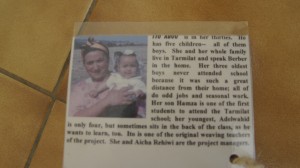
 Ito, pictured here, was one of the founders of the cooperative, and a major force in pushing for the school. One day, a Moroccan friend came to tell Karen that Ito had died, since everyone knows that Karen has been closely involved in the Tarmilat community. Karen and Fatima drove out to Tarmilat to attend something like a funeral. They sat around with a group of women mourning Ito and they all told stories about her, describing how they had known her. The next day, someone from Tarmilat came to town to tell Karen that in fact Ito was alive and well–it was a different Ito, from the same family, who had died. Now there are jokes about Karen having attended Ito’s funeral prematurely.
Ito, pictured here, was one of the founders of the cooperative, and a major force in pushing for the school. One day, a Moroccan friend came to tell Karen that Ito had died, since everyone knows that Karen has been closely involved in the Tarmilat community. Karen and Fatima drove out to Tarmilat to attend something like a funeral. They sat around with a group of women mourning Ito and they all told stories about her, describing how they had known her. The next day, someone from Tarmilat came to town to tell Karen that in fact Ito was alive and well–it was a different Ito, from the same family, who had died. Now there are jokes about Karen having attended Ito’s funeral prematurely.

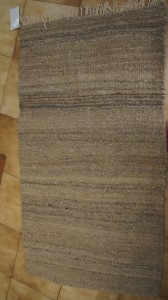
Aisha is one of the wealthier members of the Tarmilat community, as this tag notes: her husband has a hired hand; her grown son works for the city and owns a truck.
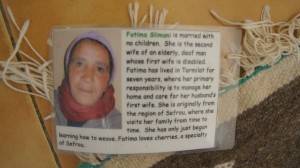
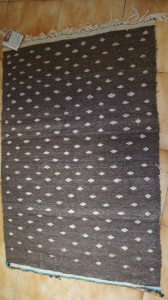
Fatima, by contrast, is the second wife of a elderly deaf man whose first wife is disabled. I can’t help but wonder about the internal dynamics of this family structure–or what Fatima’s earlier circumstances were, that made it sufficiently appealing to accept a marriage that seems mostly a formalization of caregiving responsibilities. I love the simplicity of her rug.
As it gets dark, we gather inside Ito’s house, with a dim bulb powered by a solar panel bought with proceeds from the cooperative, and the community serves us a f’tur-style dinner: bread and msemmen and hard-boiled eggs and harira soup. There’s a new baby in the community: a baby born to two 15-year-olds who were married last year. Julie Reimer tells of attending the wedding and becoming the official photographer because she was the only one with a camera. When she came back to the community to share the photographs later, the mother of the bride was (mildly) offended because Julie had not taken any pictures of her. “She was wearing a bathrobe,” Julie explains, “so I thought maybe I shouldn’t take a picture. Turns out, it was her very best bathrobe.”
I asked Karen if we could arrange for Zoe and me to have weaving lessons. “Probably. There was a student from Haverford who came and stayed at Tarmilat for three months a few years back (part of an anthropology thesis) and she learned to weave. The gendarmes were not at all happy about it, though.” Maybe once our Darija improves…
The mothers are not the only entrepreneurs here: the boys of the community build sleds out of old wooden pallets and (sometimes broken) skis. When it snows, the boys stick their sleds in the drifts by the side of the road and hire them out to tourists who have come to see the snow.
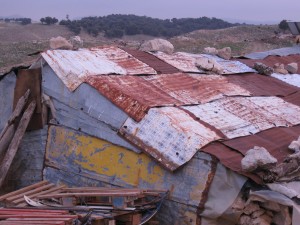
James makes friends with some of the boys by video-taping their play and then showing them the results:
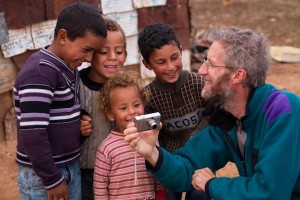
These hills are full of small communities like Tarmilat, though Tarmilat with its school and its mosque and its solar panels now ranks among the most prosperous. What would extend the (relative) success of Tarmilat to other communities in the Middle Atlas?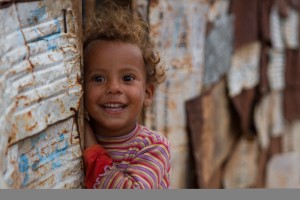
(photo by AUI student)